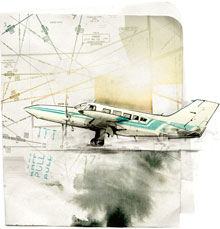 Listen to this month’s “Never Again” story: The no-nose landing. Download the mp3 file or download the iTunes podcast.
Listen to this month’s “Never Again” story: The no-nose landing. Download the mp3 file or download the iTunes podcast.
Hear this and other original “Never Again” stories as podcasts and download free audio files from our library.
In 1980, I was chief pilot for an air ambulance service based at Avi Suquilla Airport in Parker, Arizona, which is owned by the Colorado River Indian Tribes. We conducted air ambulance transport for most of the hospitals in western Arizona, transporting patients to Los Angeles, Phoenix, and Las Vegas.
We also transported patients who lived on reservations at Yuma and Peach Springs, Arizona; and Needles, California; as well as the Havasupai tribe, who lived in the Grand Canyon. There was no road into the Supai Village; in case of an emergency, the only way to get the patient out was by horse or helicopter. The helicopter was based at Grand Canyon National Park Airport, and the pilot was a Vietnam veteran. He would land in Supai and bring the patient to Grand Canyon airport, and I would fly the patient to Phoenix Sky Harbor International, where a Phoenix Indian Medical Center ambulance would be waiting.
Twice a week, I would carry nine Native American patients in a Cessna 402B to Phoenix for various treatments and dialysis. On one such trip, I departed Parker and arrived at Sky Harbor about 9 a.m. The medical center returned the passengers to the airport about 4 p.m. We then departed Sky Harbor for the flight back to Parker. I always filed IFR to keep in contact with Phoenix Departure and then Los Angeles Center.
When we approached Parker and I put the landing gear down, I noticed the nose gear light was not on, indicating the nose gear may not be down. I called flight service and asked them to contact my mechanic and have him come to the airport and watch us as we flew by. He came with binoculars and told me the nose gear was still retracted.
As I circled the airport, many things went through my mind. I knew I could land this airplane and cause no damage to the aircraft or injuries to the passengers. I had logged more than 1,000 hours in this airplane and was very familiar with its performance.
I also realized that if I made one mistake, it would cost me my aviation career. Also, if one of the main gear collapsed on touchdown, the fuel tip tank could rupture and explode, killing all of us.
I was getting low on fuel, so I decided to make the landing. I told the heavy person in the co-pilot seat to go to the rear of the airplane, sit on the floor, and forget the seatbelt. I told the rest of the passengers to unbuckle their seatbelts and follow my instructions exactly. I prayed to God to please let me do this and not hurt anyone.
I started the long final approach at normal approach speed and turned the master switch off. On short final, I slowed the airplane to minimum speed with full flaps. Just as we touched down, I turned and in a loud voice told the passengers, “Go to the rear of the airplane.” I then eased back on the control, and the airplane settled down on the tailskid and landed like a taildragger.
When the airplane stopped, the mechanic rushed to the aircraft and pulled the nosegear out and down in its locked position. The only damage to the Cessna was a broken rear strobe light.
As the passengers departed the airplane, I asked them one by one if they had any injury. They all said no. The last woman to get out of the Cessna was a member of the tribal council. She thanked God we were all OK and said, “Thank God you were our pilot.”
I later found out that a mechanic had installed an inverter in the nose compartment, and had disconnected the rods to the nose-gear doors but had not reconnected the rods. When the gear retracted, the rods caught on the side of the compartment and broke the nose-gear retracting assembly.
Looking back on this episode, I wouldn’t have done anything different unless I had been flying an airplane that could not be easily overloaded to the rear of the aircraft. This landing would not have worked on many of the twin-engine aircraft in service.
The FAA inspector came to the airport the next day to make a report. He told me he could not find any information that a landing of this type had ever been made before. I told him it should go down as a “never again” landing.
James Wells of Fyffe, Alabama, has been flying since 1970. He has an airline transport pilot certificate and logged 10,678 hours as a commercial and air ambulance pilot.


